Research potential and cognitive features of students
Abstract
This article examines the theoretical and methodological justifications for studying students’ research potential. It presents proof of the isomorphic nature of human research activity and research potential as well as of the fluid nature of its development: from research-like behavior to science-based research activity. It defines three functional components (motivational, cognitive, and behavioral) that form the structure of research potential. It further presents the results of empirically studying the cognitive features of master’s students possessing different levels of research potential. It provides data on the dynamics of research-potential components at different educational levels (bachelor’s and master’s programs). Special attention is given to a comparative analysis of evaluations by research tutors regarding their students’ research potential and of the indicators obtained using psychodiagnostic methods.
Received: 02.10.2014
Accepted: 13.10.2014
Themes: Educational psychology
PDF: http://psychologyinrussia.com/volumes/pdf/2014_4/2014_4_122-136.pdf
Pages: 122-136
DOI: 10.11621/pir.2014.0411
Keywords: research activity, research behavior, research potential, cognitive activity, cognitive features of students
Introduction
Research is a universal ability that is present in some form or other in all kinds of human activity; it forms the basis of all knowledge of the world and other people as well as of self-knowledge (Leontovich, 2003; Obukhov, 2007; Savenkov, 2005; Shumakova, 2002). The mechanisms of research activity and research-like behavior in humans, especially at an early age, are in many ways similar in their manifestations to those of animals with developed basic rational activity. The main difference between human research behavior and analogous manifestations in animals is that the need to search and research activity itself are chaneled not so much into survival as into creative activity. As we grow up, the emphasis shifts to sociocultural determination, which transforms research-like behavior into research activity. The value of research activity to society consists in its end result — the acquisition of or increase in knowledge. In functionality, research activity imitates genuine scientific search — one of many kinds of human cognitive activity — and is characterized by objectivity, reproducibility, provability, and accuracy.
Detailed descriptions of the structure of research activity (Stolyar, 1986), research skills (Fein, 1996), various types of research goals and goals with a dual educational and research basis (Dalinger, 2005; Iodko, 1983; Dalinger, Tolpekina, 2004), research attitude (Petrikhina, 2011), and the role and position of research activity in education (Brushlinski, 1983; Matyushkin, 2003; Menchinskaya, 1968; Rubinstein, 1989; Yakimanskaya, 2002) — all reflect a thorough examination of the psychological and pedagogical nature of research activity However, these descriptions pose equally important questions. Which internal conditions allow us to assume an individual is capable of generating new knowledge? What makes it possible for an individual to develop into a researcher? Why is it that every person has the potential to be a researcher but only a few turn out to be capable of it? Each of these questions makes us turn to studying those reserves of the psyche that under certain conditions become the qualities and features that define the internal basis of successful human activity In other words, they represent the potential psychological characteristics of a particular kind of activity—that is, its psychological potential.
The category of “potential” is often mentioned in books on psychology. For example, one can read about “spiritual potential,” “creative potential,” “intellectual potential,” “self-actualization potential,” “professional potential,” “developing potential.” Another example is Rotters “behavior potential” (Rotter, 1982). The term “activation potential” (also known as “encouragement potential”) was used by Berlein (1966) to describe the correlation between the motivational features of stimulation and activation. “Reaction potential” was suggested by Hull (1943) to combine force of habit and drive. In Lewins theory (Lewin, 1938) the term potentiality is used to describe the psychological force that pushes an individual toward a target area. Research potential is one of the least studied categories in psychology. The difficulty of defining it consists primarily in identifying those exact qualities and features of the subjects psyche that are combined to perform the function of scientific-research activity. Moreover, one should take into consideration the fluid nature of research potential — that is, the changes it undergoes under the influence of a persons living and learning conditions, peculiar goals, and the “uniqueness” of the result — along with the criteria of novelty and uncertainty.
According to Lomov (1984), research potential should be defined as a multidimensional and multilayered system of individual psychological traits (motivational, cognitive, and behavioral characteristics) that, acting together, make it possible for a person to conduct research activity efficiently and fruitfully as well as to solve research problems.
In the course of analyzing and comparing research-like behavior and research activity, we established the existence of at least three functional components that make research activity efficient:
- One has to want to conduct/do research; in other words, a system of motivation (the motivational component of activity) is important.
- One has to be capable of doing research; and being capable requires certain competencies to be formed at the intellectual level (to know and to understand) and the operational level (to be able to implement) (the cognitive and executive components).
- One has to establish a system of feedback that allows one to see work as rewarding and to track the results accurately in order to fine-tune one's further activity. In other words, what is required is a system of self-evaluation, self-control, and self-regulation (the behavioral component).
At the level of a subject's psychological organization, each of these functional components (motivational, cognitive, and behavioral) assumes the existence of specific psychological features and qualities that, in a research context, get activated and form the basis for conducting research activity.
The biologically conditioned research reflex is transformed into research-behavior tactics, which Lazarus and Folkman (1984) understood as specific types of reactions to new research tasks arising in the course of research activity: (a) reacting to new methods for solving a problem (problem-oriented behavior); (b) reacting to changes in one’s own attitudes toward the method of and tools for solving research problems (cognitive restructuring).
Search activity at the level of a cultural subject is transformed into a cognitive need that is aimed at creating a worldview and that serves the creative activity of a person and of society as a whole. Later, at the ethical level, the search need is realized through the formation of a scientific worldview.
Search activity transforms into research initiative — “learning independence,” according to Bogoyavlenskaya (1983) — which acts as a complete multilayered system with a great variety of components; this variety has a tendency to expand continually. At the emotional level, research initiative is characterized by, among other states, doubt and a readiness to accept dual (predicted and unpredicted) results of actions.
Research-like behavior is transformed into research activity, with qualities and features being formed that make a person a researcher.
Method
Understanding research as a peculiar type of activity that is formed on the basis of a person’s research-like behavior made it possible for us to study research potential through the lens of the structural and functional organization of a person’s purposeful intellectual and creative activity conducted with the goal of searching for (discovering) new knowledge. Certain links (components) of research activity activate the corresponding elements of a person’s mind and draw on psychological resources to perform specific actions and acts. In this light, identifying structural and functional components leads to understanding which psychological resources and reserves are necessary to implement research and to achieve its goals.
Our research is based on the model of the research potential of a student (Kostromina, 2012). The model consists of motivational, cognitive, and behavioral components. For purposes of further study we have selected certain characteristics of these components.
The motivational component creates willingness and is required to conduct research activity. The motivational component of research potential consists of intolerance for ambiguity, satisfaction in solving problems, intellectual curiosity, and intolerance for novelty. Intolerance for ambiguity is the capacity to experience positive feelings in new, unstructured, and varied situations. Intolerance allows one to perceive such situations as a challenge (Nosenko & Shapoval, 2002, p. 97). Satisfaction in solving problems is the capacity to feel gratification from the process of finding ways and means for coping with scientific tasks. Intellectual curiosity is the conscious desire to receive information about objects and to enjoy learning. Intolerance for novelty reveals the intensity of the thirst for experimentation, innovations, and so on.
The behavioral component of research potential consists of self-organization, self-control, adaptability, and assertiveness. Self-organization is the structuring of a researcher’s personal activity to reach objectives. Self-control is reflected in following research procedures and completing work tasks. Adaptability reduces the time necessary to accept the changing conditions of a research task Assertiveness is maintaining stability while working in unstable conditions.
The cognitive component provides knowledge and skills for implementing research activity. It includes thinking that is flexible, critical, logical, quick, and original. Flexibility of thinking is the capacity to widely use one’s experience, to study subjects using new relationships and connections, and to overcome conventional thinking. Critical thinking is the capacity to reveal mistakes and inconsistency, to correct errors, to find the strengths and weaknesses of evidence, to justify the validity of a hypothesis. Logical thinking is the ability to use facts and laws to confirm the accuracy of conclusions promptly. Quickness of thinking is the ability to understand a situation and to make decisions in a timely manner. It depends on knowledge and the level of the development of thinking skills. Originality of thinking is the capacity to propose new, unconventional ideas.
The goal of the empirical part of this research was to investigate a variety of research-potential characteristics among students and professors in two Russian universities (Saint Petersburg State University and Herzen Russian State Pedagogical University). Students at various levels and university professors participated in this research: bachelor’s degree students (79), master’s degree students (94), and professors (40). All the participants were working toward degrees or teaching courses in the humanities.
In the other part of the empirical research we compared the cognitive features of students with different levels of research potential (high and low). The sample group consisted of 40 master’s degree students in the first and second years of study in the faculties (departments) of history (17 students) and psychology (23 students); 15 of them were first-year students, and the other 25 were second-year students.
Research methods
Research was conducted using our research-potential questionnaire (Bordovskaia, Kostromina, Rosum, Moskvicheva, & Iskra, 2012).
Data analysis
Data analysis was conducted using the Mann-Whitney test for comparison of groups. The differences were accepted as significant at the level of 5% (p<0.05). Correlation analysis was used to study the interaction of the characteristics of research potential and the age of participants. The interactions were accepted as significant at the level of 5% (p < 0.05).
Results
Interactions between age and characteristics
The correlation analysis did not reveal any statistically significant correlations between the age of participants and the characteristics of the research-potential components.
Results of a comparison between groups on a variety of characteristics of the research-potential components
The motivational component
A pairwise comparison of groups comprising bachelor students and master s students revealed the differences presented in Figures 1 and 2. The results obtained for intolerance for ambiguity were not significantly different for students at the bachelor’s level and those at the master level, but valid differences appeared between the bachelor students and the professors as well as between the master students and the professors. Higher scores on this characteristic in the professorial group suggest that scientific activity leads to the ability to perceive scientific uncertainty as a challenge that requires an answer in the form of a solution to a problem.
The highest scores on the characteristic of satisfaction from solving the problem were obtained by the group of professors, with average scores coming from the students at the bachelor level and the lowest scores from the students at the master s level. We can assume that the differences indicate that the level of scientific problems presented at the bachelor level allows solving them faster, and therefore it is easier for students at this level to achieve satisfaction from the resolution. The decrease in this score at the master level may be due to the fact that scientific work at this level requires a long-term (2-year) period, and therefore it is difficult for these students to achieve satisfying scientific results quickly. We associate the higher scores on this characteristic in the group of professors with the variety in the timing and the quality of the scientific work they do.
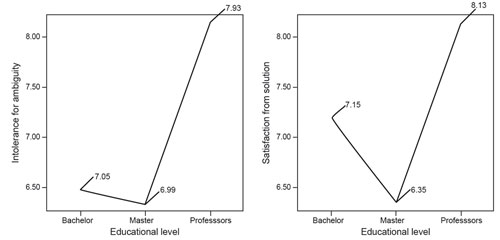
Figure. 1. Differences between groups on the characteristics of intolerance for ambiguity and satisfaction from solution.
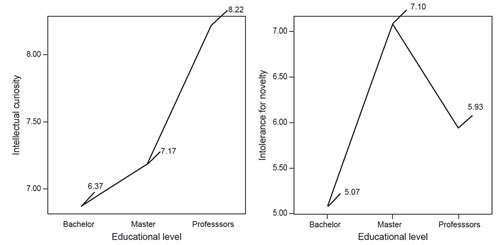
Figure 2. Differences between the groups on the characteristics of intellectual curiosity and intolerance for novelty.
Scores on intellectual curiosity increased linearly from the bachelor level to the master level and then to the professors (Figure 2). Most likely, the accumulation of scientific knowledge and the experience of research lead to an increased desire to find scientific information and motivate researchers to expand scientific boundaries.
The highest scores on the characteristic of intolerance for novelty were achieved by the students at the master’s level; the scores then decreased at the professorial level, and even lower scores were registered by the students at the bachelor’s level. In other words, willingness to experiment and the use of new and unknown methods for solving problems were most evident at the master’s level. Experience in scientific activity may have a nonlinear effect on the expression of this characteristic.
Low scores on intolerance for ambiguity, intellectual curiosity, and intolerance for novelty and average scores on satisfaction from solution were found at the bachelor level. This finding may indicate that the motivational component of research capacity at the bachelor’s level is not formed sufficiently, although there is basic support from the satisfaction of solving a problem. Low levels of intolerance for ambiguity and satisfaction from solution in conjunction with average rates of intellectual curiosity and high rates of intolerance for novelty were revealed at the master level. This finding may indicate that the main motivating factor in master’s students’ research work is the opportunity for experimentation, the search for different ways of solving a research problem. High levels of the characteristics of intolerance for ambiguity, satisfaction from solution, and intellectual curiosity and average rates of intolerance for novelty were found at the professorial level. This finding suggests that in the course of ongoing research and experimental activity the need to search for new scientific solutions may decrease.
Thus, the motivational component displays characteristics that vary nonlin- early depending on the level of education and, consequently, on the experience of scientific research; this nonlinearity indicates the indirect effect of these parameters (experience) on the characteristics of intolerance for ambiguity, satisfaction from solution, and intolerance for novelty. At the same time, another characteristic— intellectual curiosity—varies linearly: it increases with the increase in the level of education and in the experience of scientific activity; this finding suggests that learning and working conditions may affect its development.
The behavioral component
A pairwise comparison of the characteristics of the behavioral component revealed a difference in the groups. Figure 3 shows that the level of self-organization in research potential was the highest at the professorial level and at the bachelor level and decreased at the master’s level.
Educational and research activities have equal roles at the master level. The complexity of scientific problems increases with a simultaneous change in the nature of supervisors’ involvement in the academic work of students. Scientific activity and the experience obtained during work on a master’s degree may lead to a decrease in the self-organization of scientific activity.
Differences in self-control during research activities are shown in Figure 3. Scores on self-control were significantly different between the groups of bachelor’s and master’s students as well as between the groups of bachelor’s students and professors, while there were no significant differences between the master’s students and the professors. This finding may indicate that self-control is developed during the final years of education, when students conduct their research work independently. In the third year of education research activity is carried out mostly under the supervision of a professor.
Scores on the adaptability characteristic increased from the bachelor’s level to the master’s level, but they did not change from the master’s level to the professorial level. The accumulation of experience in research may lead to a decrease in the time needed to adapt to changes in the conditions of a scientific problem or to the emergence of new conditions.
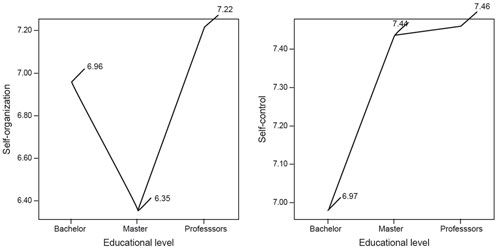
Figure 3. Differences between groups on the characteristics of self-organization and self- control.
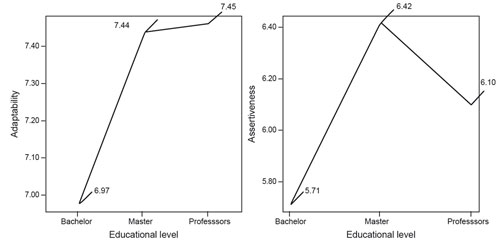
Figure 4. Differences between groups on the characteristics of adaptability and assertiveness.
The level of assertiveness significantly increased from the bachelor s level to the master level and slightly decreased at the professorial level (Figure 4).
Thus, bachelor degree students are characterized by lower levels of self-control, adaptability, and assertiveness while possessing a high degree of self-organization. This fact may indicate that students at this educational level do not have any formed behavioral stability in the face of external influences and changes in the conditions of research activities, but they compensate by having a high level of self-organization. Master students are characterized by high rates of self-control, assertiveness, and adaptability as well as low rates of self-organization; this finding indicates that behavioral stability has been developed and that scientific work can be done at a lower level of self-organization.
The cognitive component
The highest level of the characteristic of flexibility of thinking was achieved at the professorial level, as Figure 5 shows. The levels of flexibility of thinking are not significantly different when we compare bachelor and master students.
The characteristic of critical thinking increased linearly from the bachelor to the master level and showed no significant differences at the master and professorial levels.
The characteristics of logicality and quickness (of thinking) increased linearly from the bachelor level to the master level and then on to the professorial level (Figure 6). Possibly these characteristics of research potential develop in the process of research activity and with increased experience in identifying scientific problems as well as in looking for different ways of solving them.
No differences between the groups were found in originality of thinking, perhaps because this characteristic is not taught in the process of learning and conducting research work.
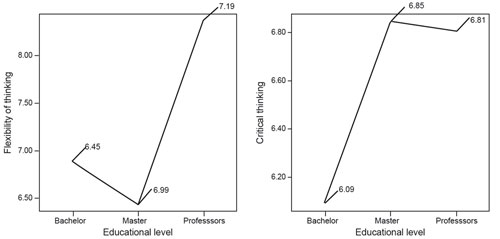
Figure 5. Differences between groups on the characteristics of flexibility of thinking and critical thinking.
Thus bachelor degree students are characterized by lower rates of flexibility of thinking, critical thinking, and logicality and quickness (of thinking). Master students have average rates of logicality and quickness, lower rates of flexibility of thinking, and the highest rates of critical thinking. Finally, professors score the highest on all the characteristics of the research-potential cognitive components, excepting critical thinking.
Results of a comparative analysis of cognitive features in master degree students with a high, medium, or low level of research potential.
To prove the resource role of a self-regulated system of cognitive processes in developing research potential, we can look at differences in the cognitive features of students with a high or a low level of research potential (RP). This conclusion can be drawn only through understanding that research activity can be efficient if the researcher has already acquired certain competencies (knowing and understanding) at the intellectual level.
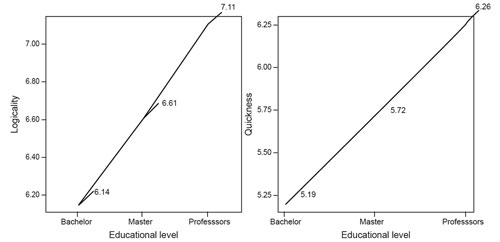
Figure 6. Differences between groups on the characteristics of logicality and quickness (of thinking).
In order to conduct a comparative analysis, the respondents were divided into three groups based on their overall RP score:
Group 1 — a low level of RP (273-315 points): 30.8% of the master's degree students
Group 2 — a medium level of RP (316-356 points): 35.9% of the master's degree students
Group 3 — a high level of RP (357-403 points): 33.3% of the master's degree students
A comparison of all three groups simultaneously using the Kruskal-Wallis test revealed significant differences (p<0.05) in the following characteristics:
- Amthauer's subtest 4 (generalization, level of development of abstract thinking)
- verbal-intelligence coefficient
- theoretical abilities
- analytical style indicators
- motivational, cognitive, and behavioral components of RP
In order to specify these distinctions, a pairwise comparison of the groups was conducted using the Mann-Whitney U test.
Significant differences according to Amthauer's intelligence-structure test were identified (Figure 7):
- in subtest 1 (analyzing the terms of the problem), between the groups with medium and high levels of RP
- in subtest 4 (development of abstract thinking), between the groups with low and high levels of RP, as well as between the groups with medium and high levels of RP
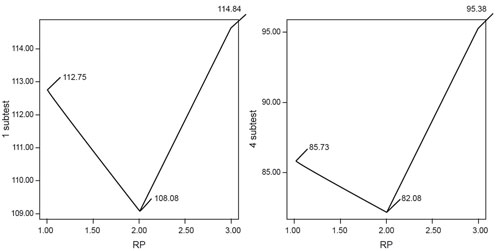
Figure 7. Differences in the indicators of subtests 1 and 4 of Amthauer’s test in groups with low, medium, and high levels of RP.
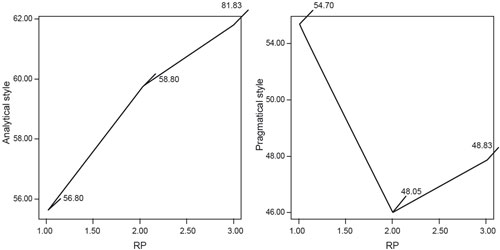
Figure 8. Differences in indicators of analytical and pragmatic style in groups with low, average, and high levels of RP.
Thus, the indicators of subtests 1 and 4 of Amthauer’s intelligence-structure test demonstrated nonlinear changes correlating with the degree of RP development among the master’s students. Moreover, the group with a high level of RP scored highest on these subtests.
Figure 8 shows that the indicators of analytical-mode abilities increased with an increase in the level of master’s students’ RP, while the indicators of pragmatic mode abilities decreased significantly when shifting from low to medium levels of RP but did not reveal any significant differences in groups with medium and high levels of RP. Using these data, we can conclude that analytical abilities play a larger role in helping develop RP than do pragmatic one’s. Thus, as RP and its individual components develop, one tends to draw less on one’s personal experience.
The tendency to use only the input and information that are readily available decreases, while the desire to get concrete, albeit limited, results increases.
At the same time, increased emphasis is given to the role of rational methods of working with unknown objects and conditions.
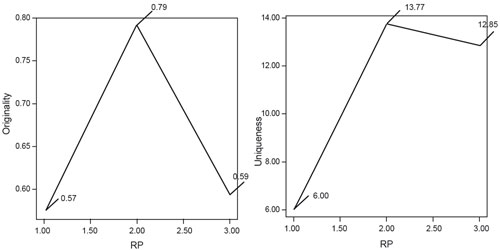
Figure 9. Differences in indicators of originality and uniqueness according to Medniks test of verbal creativity in groups with low, average, and high levels of RP.
In Figure 9, we can see that the qualities of originality and uniqueness in cognitive activity assume a major role when shifting from a low level of RP to a medium one. Possibly, these characteristics are key to creating a qualitative increase in research abilities among master degree students whose levels of RP are initially low. At the next level, originality and uniqueness no longer play an essential role in a person’s research activity.
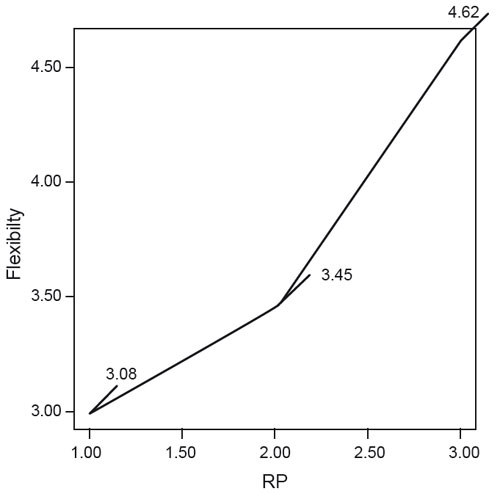
Figure 10. Differences in the indicators of flexibility in groups with low, average, and high levels of RP.
Figure 10 illustrates linear changes in the indicators of flexibility in groups with different levels of research potential. A significant increase in the flexibility of thinking in accordance with the level of RP correlates with a similar increase in the degree of awareness of the situation as well as in the freedom to choose methods of solving problems and to change the course of research.
Results of a multiple linear regression analysis: How cognitive characteristics influence students’ research potential
The influence of cognitive characteristics on the degree of research potential was verified using the method of multiple linear regression analysis (a step-by-step method with the inclusion of variables). As a result, it was established that the only factor having a significant influence on research potential is theoretical thinking abilities according to Amthauer s intelligence-structure test (f=3.373; p=0.001). The other cognitive characteristics (modes of thinking, certain logical operations, flexibility, reflective thinking, originality, and uniqueness of thinking) do not contribute significantly to the overall level of research potential.
Theoretical thinking abilities are the aggregate of analytical and synthesizing skills aimed at identifying common features and qualities of objects, as well as abilities aimed at generalization and abstract thinking. These abilities function at a high level along with a broad vocabulary range, and they reflect one’s ability to think in the abstract. This finding reflects the important role of conceptual thinking in developing research potential and confirms the available scientific data showing that in order for scholars to realize their research potential highly developed thinking skills or intelligence are required.
At the same time, the function of the other cognitive characteristics in the overall level of research potential is revealed in conjunction with the separate components of research potential. For instance, the correlation we established between the level of development of the motivational and behavioral components and the analytical style of thinking is confirmed when comparing groups with low, medium, and high levels of research potential. Among master’s degree students with high levels of research potential the prevalence of this mode of thinking has been established. In conjunction with the established connection to flexibility of thinking, which increases in a linear fashion along with an increase in research-potential levels, we can see a certain direction of thought that is characterized, on the one hand, by being aimed at collecting information, developing a detailed plan of problem-solving, and viewing the world as logical and predictable, and, on the other hand, by possessing a certain flexibility, which consists in one’s ability to change one’s approach to a given task and to find new and unconventional methods of dealing with it.
Conclusions
1. The analysis performed within the study of research-potential characteristics at the bachelor’s, master’s, and university professorial levels leads us to conclude the following:
- Characteristics of the motivational, behavioral, and cognitive components of research potential are not connected with age characteristics.
- Intolerance for novelty, self-control, adaptability, assertiveness, and critical thinking are the characteristics of research potential that are developed in the process of learning at the university level.
- Intellectual curiosity, logicality, and quickness (of thinking) tend to be developed more in the process of research activity than in the course of academic studies.
2. General characteristics of cognitive activity are as follows:
Master’s students exhibiting high levels of research potential tend to be highly capable of implementing the knowledge they possess, making generalizations based on that knowledge, and being flexible; in addition, they possess a highly analytical mode of thinking and they avoid a pragmatic mode of thinking (they hardly ever use their personal experience based on easily available information to achieve a quick and concrete result). At the same time, this group is characterized by average levels of originality as well as a high degree of unique verbal creativity.
Master’s students exhibiting low levels of research potential tend to have poorly developed abstract thinking, average capacities for analyzing a situation, and a propensity to avoid using the analytical mode of thinking in favor of using a predominantly pragmatic mode; they also exhibit average levels of originality in thinking, low levels of uniqueness, and low levels of flexibility in thinking.
3. No link was found between master’s students’ level of research potential and their capacities for reflexive thinking and verbal creativity.
4. The following specific features were found:
No correlation exists between master’s students’ level of research potential and the evaluation of their research potential by their research advisors.
A reverse correlation exists between the evaluation of students’ research potential by their research advisors and the students’ practical capabilities and verbal intelligence.
Positive correlations exist between research advisors’ evaluations of students’ research potential and the degree to which that potential has been realized and students’ showing signs of scientific activity, such as participating in science conferences and publishing their work.
These features point to a gap between the external evidence of research activity and the genuine research capabilities of master’s students. When evaluating the degree to which students are realizing their research potential, research advisors tend to focus on external evidence that reflects students’ involvement in promoting themselves and the results of their research.
5. Using the method of regression analysis, we obtained data on the high predictive validity of theoretical abilities in defining students’ level of research potential; these data confirm the scientific thesis that the realization of research potential requires a high level of conceptual thinking or verbal intelligence in general.
Acknowledgements
The study was supported by the Russian Foundation for Humanities, project 14-06- 00521 “Neuropsychological mechanisms of complicated kinds of intellectual activity developing in the higher school education”.
References
Berlein, D. E. (1966). Intellectual curiosity and search for data. Voprosy Psychologii [Issues in Psychology], 3, 54-60.
Bogoyavlenskaya, D. B. (1983). Intelectual activity as the issue of creativity. Rostov-na-Donu: Rostov University Press.
Bordovskaia, N. V., Kostromina, S. N., Rosum, S. I., Moskvicheva, N. L., & Iskra, N. N. (2012). Activity approach to the study of research potential of students. International Journal of Experimental Education, 1,81-88.
Brushlinski, A. V. (1983). Psychology of thinking and problem-solving education. Moscow: Znanie.
Dalinger, V. A. (2005). Students’ research activity on mathematics: work-book. Omsk State University Press.
Dalinger, V. A., & Tolpekina, N. V. (2004). Organization and content of the students’ research activity on mathematics: work-book. Omsk State University Press.
Fein, T.D. (1996). Effects of suspicion on attributional thinking and the correspondence bias. Journal of Personality and Social Psychology, 70, 1164-1184. doi: 10.1037/0022-3514.70.6.1164
Hull, C. (1943). Principles of Behavior. New York: Appleton-Century-Crofts.
Iodko, A. G. (1983). Forming of the students’ research skills in chemistry learning process. PhD dissertation.
Kostromina, S. N. (2012). Psychological factors of self-organization academic activity of students. Journal of International Scientific Publications: Educational Alternatives, 10(2), 187-196.
Lazarus, R. S., Folkman, S. (1984). Stress, Appraisal and Coping. N.Y.: Springer.
Leontovich, A. V. (2003). Research activity of pupils. Handbook. Moscow: MGDD(U)T.
Lewin, K. (1938). The Conceptual Representation and the Measurement of Psychological Forces. Duke University Contributions to Psychological Theory, 1(4), 247.
Lomov, B. F. (1984). Methodological and Theoretical Problems of Psychology. Moscow: Nauka.
Matyushkin, A. M. (2003). Thinking, learning, creativity. Moscow-Voronezh: MODEK.
Menchinskaya, N. A. (1968). Psychological issues of developmental teaching and the new paradigms. Sovetskaya pedagogika [Soviet Education], 6, 21-38.
Nosenko, I., & Shapoval, M. (2002). Tolerance of ambiguity as system personal factor of creativity. Psychology and Society, 1,97-106.
Obukhov, A. S. (2007). The research attitude of the personality. Shkol’nye tekhnologii [School Technologies], 5,21-24.
Petrikhina, A. S. (2011). Psychological structure and functions of pupils’ research attitude. Evropeiskii zhurnal sotsial’nykh nauk [European Journal of Social Sceince], 8, 232-240.
Rotter, J. B. (1982). The development and applications of social learning theory: selected papers. New York: Praeger.
Rubinstein, S. L. (1989). Bases of general psychology. Vol. 2. Moscow: Pedagogika.
Savenkov, A. I. (2005). Way to the novel: Development of research abilities of school students: Teacher edition for school psychologists. Moscow: Genesis.
Shumakova, N. B. (2002). Research as the basis of learning. From research activity to reseach work of high school students. (The experience of school №1624 “Sozvezdie” in the frame of interdisciplinary program “Gifted child”), (pp. 5-11). Moscow: YuOUO.
Stolyar, A. A. (1986). Pedagogy of mathematics. Minsk: Vyshaya shkola.
Yakimanskaya, I. S. (2002). Person-centered approach in education at contemporary school. Moscow: Sentyabr.
To cite this article: Kostromina S.N., Bordovskaia N.V., Rosum S.I., Moskvicheva N.L., Iskra N.N. (2014). Research potential and cognitive features of students. Psychology in Russia: State of the Art, 7(4), 122-136.
The journal content is licensed with CC BY-NC “Attribution-NonCommercial” Creative Commons license.










